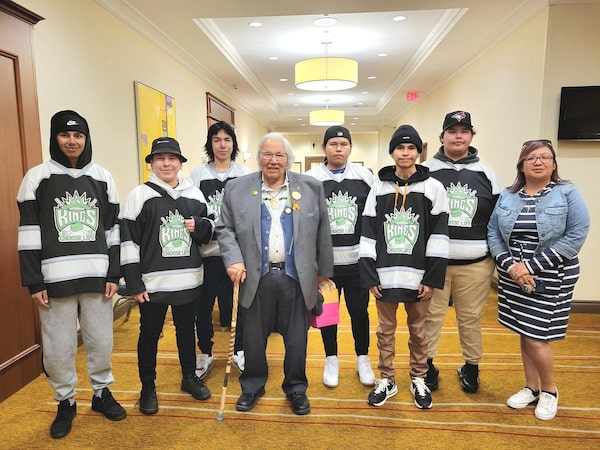
Former senator Murray Sinclair stands with six members of the KI Kings and team manager Leona Cutfeet at the Choose Life general meeting in September. (Photo courtesy Leona Cutfeet)Handout
Just more than five years ago, seven girls from First Nations communities across northern Ontario saw through a haunting suicide pact. Alayna Moose, Kanina Sue Turtle, Jolynn Winter, Chantell Fox, Amy Owen, Jenera Roundsky, Jeannie Grace Brown – the loss of each child devastated their families, their friends and their Nishnawbe Aski Nation (NAN) communities.
Then later that year came another stunning, horrific loss: the suicide of Alyssa Nanokeesic, an 11-year-old girl from Kitchenuhmaykoosib Inninuwug (KI).
No child asks to be born into the weight of history. But being born in Canada has made Indigenous children vulnerable to genocidal policies such as the Indian Act and Indian residential schools, which have violently ripped families apart or destructively separated Indigenous peoples off their lands and from each other.
But in the five years since the girls died, something miraculous has happened – something that came from the tragedies, and emerged directly from the communities. It’s called Choose Life: a NAN-specific program that provides children, families and communities with fast-tracked access to health and social services and culturally-based supports to engage youth at risk of suicide. The federally funded initiative also offers a land-based healing program that teaches youths to be proud of who they are and where they come from.
Late last week, on the eve of the National Day for Truth and Reconciliation, NAN held the first Choose Life annual general meeting in Ottawa. There, Grand Chief Derek Fox, Deputy Grand Chief Bobby Narcisse and Indigenous Services Minister Patty Hajdu signed a terms-of-reference agreement, which commits them to negotiating long-term federal funding for the program. In the crowd was Alvin Fiddler, who as the former NAN grand chief had pushed for Choose Life to become permanent, not a budgetary line item that could potentially easily be cut by future governments.
There were some other special guests in the audience, too: the KI Kings hockey team, which was integral in the naming of the Choose Life program five years ago.
Leona Cutfeet, a KI mom and the team’s manager, remembers that day clearly. The team had travelled to a hockey tournament in Sioux Lookout, Ont., and organizers had asked if they would honour Alyssa’s passing in some way, and say something to the youth. But it seemed that the players had been sapped of hope and happiness, and replaced instead with despair and confusion. “We all sat there, dumbfounded and at a total loss for words,” she wrote on Facebook.
So they prayed – for their families, and for the families affected by the suicides. Then suddenly, Ms. Cutfeet said, words came screaming out of her mouth: “Choose life!” She and her friend Jodi Albany leapt up, went to a nearby Walmart and bought 10 pieces of bright green Bristol board – one for each letter of “Choose life.” The players brought the signs onto the ice at the start of the game for a moment of silence. When it was done, Ms. Cutfeet remembers that the crowd looked at the boys holding the signs and let loose a “loud roar of hope” – “it was a magical moment,” she wrote.
It must be noted that Choose Life was funded by the federal government through the immensely important Jordan’s Principle, which was developed out of a need to deliver funds, equitably and without delay, to First Nations children who need health care or social services. Jordan’s Principle was named for Jordan River Anderson, the Norway House Cree Nation boy who died while various levels of government fought over who should pay his medical bills.
Last week, Ms. Cutfeet and the former members of the KI Kings were all in Ottawa, on hand to make sure what they helped start never stops. That they all keep going.
They even got to meet former senator Murray Sinclair, who came to the meeting in order to cheer everyone on. Ms. Cutfeet told me that they were all “so inspired and honoured to have met him.”
This is what hope looks like: driven by First Nations peoples, supported by allies, run by love and a commitment from all to make sure each child feels pride in who they are and knows that they belong. It is beyond unfortunate that so many kids had to be lost for us to get here, so many families and lives altered forever due to the loss of a child. That is why when communities rise up, and chart their own course for meaningful change, we must celebrate.
As Mr. Sinclair always says, we know, deep down, the answers and way forward that will lead us to success. Those are the same teachings, languages and laws that have led us for tens of thousands of years. Indigenous peoples know what they need to survive and thrive.
 Tanya Talaga
Tanya Talaga